The Basel problem is a problem in mathematical analysis with relevance to number theory, first posed by Pietro Mengoli in 1650 and solved by Leonhard Euler in 1734, and read on 5 December 1735 in The Saint Petersburg Academy of Sciences Since the problem had withstood the attacks of the leading mathematicians of the day, Euler's solution brought him immediate fame when he was1=2 A Proof using Beginning Algebra The Fallacious Proof Step 1 Let a=b Step 2 Then , Step 3 , Step 4 , Step 5 , Step 6 and Step 7 This can be written as , Step 8 and cancelling the from both sides gives 1=2 See if you can figure out in which step the fallacy liesTheorem The sum of the first n powers of two is 2n – 1 Proof By inductionLet P(n) be "the sum of the first n powers of two is 2n – 1" We will show P(n) is true for all n ∈ ℕ For our base case, we need to show P(0) is true, meaning the sum of the first zero powers of two is – 1 Since the sum of the first zero powers of two is 0 = – 1, we see
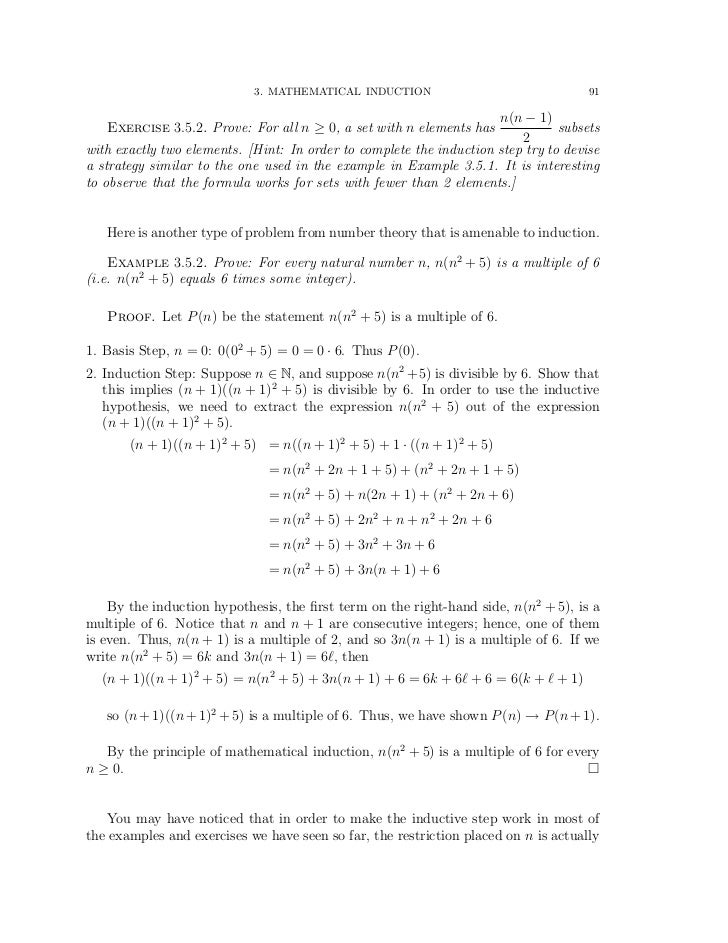
Math Induction
1^2+2^2+3^2+...+n^2 formula proof
1^2+2^2+3^2+...+n^2 formula proof-Archimedes ( BC) also derived the formula 1^2 2^2 3^2 n^2 = n(n 1)(2n 1)/6 for the sum of squares Fill in any missing details in the following sketch of his proofExample 343 Use mathematical induction to show that 3 n ∑ i = 1(3 5i) = (n 1)(5n 6) 2 for all integers n ≥ 1 Answer Proceed by induction on n When n = 1, the lefthand side reduces to 3 ( 3 5) = 11, and the righthand side becomes 2 ⋅ 11 2 = 11;




Proofs Without Words And Beyond Proofs Without Words 2 0 Mathematical Association Of America
Here's how it works Assume that we have two variables a and b, and that a = b Multiply both sides by a to get a2 = ab Subtract b2 from both sides to get a2 b2 = ab b2 This is the tricky part Factor the left side (using FOIL from algebra) to get ( a b ) ( a b) and factor out b from the right side to get b ( a b )21 FORMULA is effective on light oil and grease stains When working with paint stains, it can be difficult to distinguish between a latex and other paints Because 21 FORMULA is effective on some oilbased paints, the formula has gained popularity as a general paintoilgrease remover Soluble in Water and SolventSolve for n 2/3*(1n)=1/2n Simplify Tap for more steps Apply the distributive property Multiply by Combine and Combine and Move all terms containing to the left side of the equation Tap for more steps Add to both sides of the equation To write as a
Induction Examples Question 7 Consider the famous Fibonacci sequence fxng1 n=1, de ned by the relations x1 = 1, x2 = 1, and xn = xn 1 xn 2 for n 3 (a) Compute x (b) Use an extended Principle of Mathematical Induction in order to show that for n 1, xn = 1 Mind Your Puzzles is a collection of the three "Math Puzzles" books, volumes 1, 2, and 3 The puzzles topics include the mathematical subjects including geometry, probability, logic, and game theory Math Puzzles Volume 1 features classic brain teasers and riddles with complete solutions for problems in counting, geometry, probability, and game theoryI have wondered how the closed form for the sum of squares for the first n natural numbers was derived Given the formula for the sum 1^22^2n^2= n(n1)(2n1)/6 I learned to prove its correctness using mathematical induction However, I never
Formula for In example to get formula for they express as also known that , , and Then this values are inserted into function, we get system of equations solve them and get a,b,c,d coefficients and we get that Then it's proven with mathematical induction that it's true for any n And question is, why they take 4 coefficients at theUse mathematical induction to prove that 2462n = n^2n true for all natural numbers 1 Educator answer eNotescom will help you with any book or any question4 Find and prove by induction a formula for Q n i=2 (1 1 2), where n 2Z and n 2 Proof We will prove by induction that, for all integers n 2, (1) Yn i=2 1 1 i2 = n 1 2n Base case When n = 2, the left side of (1) is 1 1=22 = 3=4, and the right side is (21)=4 = 3=4, so both sides are equal and (1) is true for n = 2 2




Binomial




1 2 3 4 Wikipedia
see below to prove by induction 123n=1/2n(n1) color(red)((1) " verify for " n=1) LHS=1 RHS=1/2xx1xx(11)=1/2xx1xx2=1 "true for "n=1 color(red)((2)" to prove$2 \cdot T(n) = n(n1) => T(n) = \frac{n(n1)}{2}$ Triangular number just happen to arrange themselves in a simple pattern of an arithmetic progression of consecutive numbers What Gauss did was think of this algebraically1^2 2^2 3^2 n^2 = n(n1)(2n1)/6 for all positive integral values of n Answer by solver() (Show Source) You can put this solution on YOUR website!
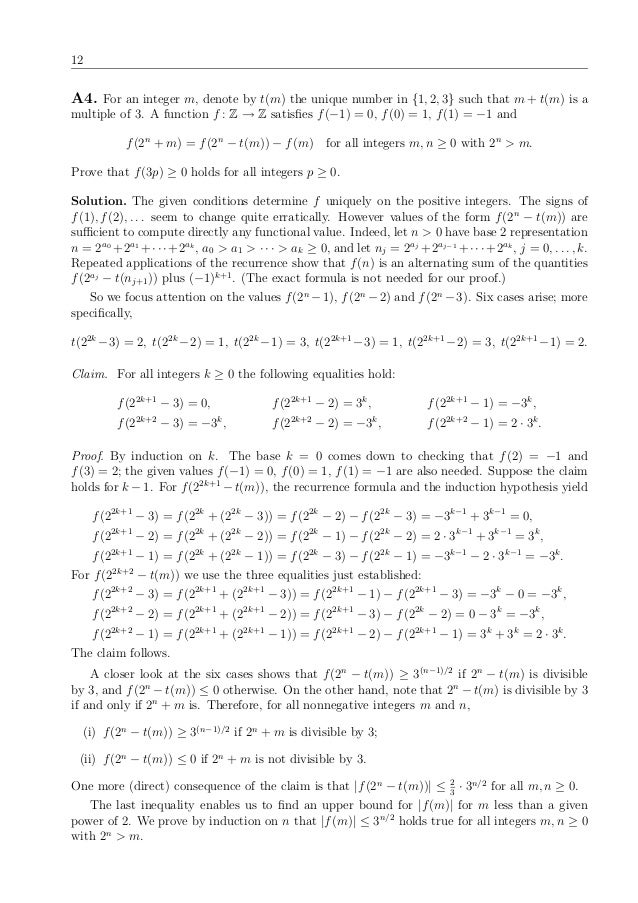



Imo08 Sl




Show That One And Only One Out Of N N 1 And N 2 Is Divisi
The left side is `1*2=2` The right side is `1/3 1(2)(3)=2` so the statement is true for n=1 = n/2 (3n 1)` Use mathematical induction to prove the formula for every positive integer nExercise 17 (See 123 in text) There exists a positive real number x ∈ Rsuch that x2 = 2 For our purpose the Least upper bound axiom is the most important one Theorem 18 (Archimedian Property) Let x,y ∈ R with x > 0 Then there exists n ∈ N such that nx > y Proof Suppose notSum of n, n², or n³ n n are positive integers Each of these series can be calculated through a closedform formula The case 5050 5050 5050 ∑ k = 1 n k = n ( n 1) 2 ∑ k = 1 n k 2 = n ( n 1) ( 2 n 1) 6 ∑ k = 1 n k 3 = n 2 ( n 1) 2 4



n2 Formula
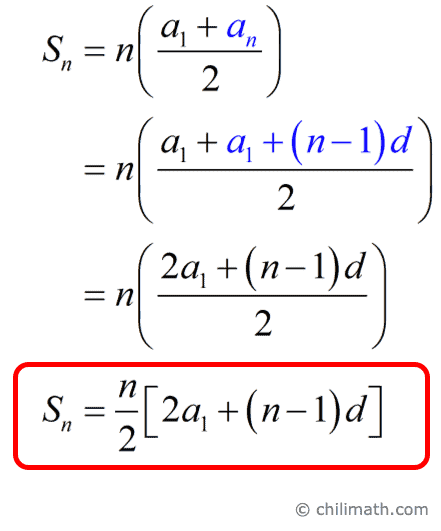



Arithmetic Series Formula Chilimath
22 This problem happens to have appeared on the Polish Mathematical Olympiad camp in 15 Here is the official solution of the problem (I use m in place of x because this is how the problem was stated there) Suppose first n is even, say n = 2k Then the equation is equivalent to (3k 1)(3k − 1) = 2m2 Clearly gcd (3k 1, 3k − 1) = 2(*) For n > 5, 4n < 2 n This one doesn't start at n = 1 , and involves an inequality instead of an equation (If you graph 4 x and 2 x on the same axes, you'll see why we have to start at n = 5 , instead of the customary n = 1 ) Example 1 For all n ≥ 1, prove that 12 22 32 42 n2 = (n(n1)(2n1))/6 Let P (n) 12 22 32 42 n2 = (n(n1)(2n1))/6 For n = 1, LHS = 12



Search Q Summation Formulas Tbm Isch




The Wallis Product Formula For Pi And Its Proof Mind Your Decisions
Prove 1 Show that is true for and 2 Assume is true for some positive integer , then show the Notice that the formula is really similar to that for the first natural numbers Proof Plugging in =, we find that () = () =, completing our base step Aside from being good examples of proof by simple or weak induction, these formulas are useful to find an integral as a limit of a Riemann sumProve that 122 2 2 3 2 n1 = 2 n 1 for n = 1, 2, 3, There are two steps in a proof by induction, first you need to show that the result is true for the smallest value on n, in this case n = 1 When n = 1 the left side has only one term, 2 n1 = 2 11 = 2 0 = 1 The right side is 2 n 1= 2 1 1 = 1 Thus the statement is true for




1 2 3 N N N 1 2n 1 6




Analysis Of Algorithms Ii Ppt Video Online Download
2/3 (1n)=1/2n Simple and best practice solution for 2/3 (1n)=1/2n equation Check how easy it is, and learn it for the future Our solution is simple, and easy to understand, so don`t hesitate to use it as a solution of your homework If it's not what You are looking for type in the equation solver your own equation and let us solve itIn this video I demonstrate that the equation 1 2 2^2 2^3 2^(n1) = 2^n 1 for all positive integers using mathematical induction The first s 21 For the proof, we will count the number of dots in T (n) but, instead of summing the numbers 1, 2, 3, etc up to n we will find the total using only one multiplication and one division!



How To Prove That Math Frac 2 N 2 N 1 2 N 1 2 N 3 2 Quora
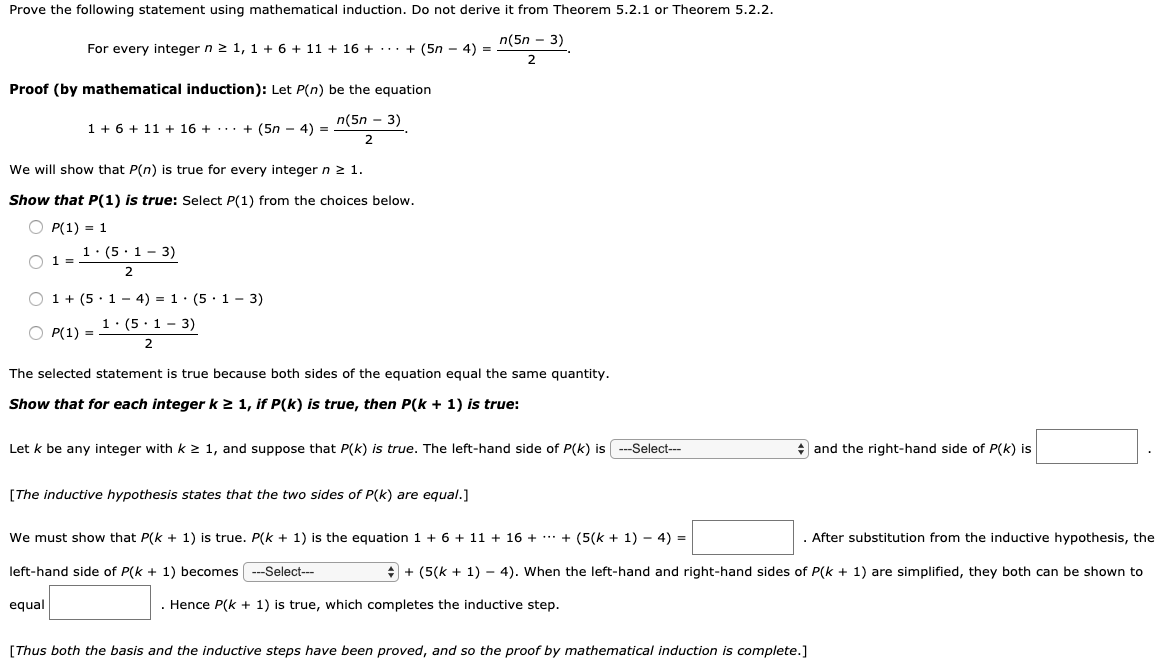



Prove The Following Statement Using Mathematical Chegg Com
A summation method that is linear and stable cannot sum the series 1 2 3 ⋯ to any finite value (Stable means that adding a term to the beginning of the series increases the sum by the same amount) This can be seen as follows If 1 2 3 ⋯ = x then adding 0 to both sides gives 0 1 2 ⋯ = 0 x = x by stability I would like some help with deriving a formula for the sum $1^2 2^2 \cdotsn^2$ using generating functions I have managed to do this for $1^2 2^2 3^2 \cdots Davneet Singh is a graduate from Indian Institute of Technology, Kanpur He has been teaching from the past 10 years He provides courses for Maths and Science at Teachoo




The Value Of 1 1 2 3 1 2 3 4 1 N N 1 N 2 Is



How To Prove That Math Frac 2 N 2 N 1 2 N 1 2 N 3 2 Quora
Question Find A Formula For 1/12 1/2*3 1/n*(n 1) By Examining The Values Of This Expression For Small Values Of N Prove The Formula You Explanation using the method of proof by induction this involves the following steps ∙ prove true for some value, say n = 1 ∙ assume the result is true for n = k ∙ prove true for n = k 1 n = 1 → LH S = 12 = 1 and RHS = 1 6 (1 1)(2 1) = 1 ⇒result is true for n = 1 Homework Helper 3,798 94 Little ant said 1^2 2^2 3^2 2^n = 2^ (n1) This makes absolutely no sense I mean, look at it for a second firstly you failed to notice the pattern correctly since 2^n means 2^12^22^3 instead of what is shown And secondly, how can that all equal 2^ (n1) when on the left side of the equation, you



On Some Formulae For Ramanujan S Tau Function Pdf Free Download




n2 Formula
Equations Tiger Algebra gives you not only the answers, but also the complete step by step method for solving your equations (n/n3)/(2n2/n^22n3) so that you understand betterHere is a pattern which does not depend on n Multiply by 3 3 3^2 3^n1 3^n = 3S Subtract the first from the second 1 00 0 3^n = 2S Divide by 2 and you have your solution Using induction is possible, but does not add to the understanding of most students At a key level, I believe in Street Fighting mathematicsThe sum of the first n squares, 1 2 2 2 n 2 = n(n1)(2n1)/6 For example, 1 2 2 2 10 2 =10×11×21/6=385 This result is usually proved by a method known as mathematical induction, and whereas it is a useful method for showing that a formula is true, it does not offer any insight into where the formula comes from




Proof Of Finite Arithmetic Series Formula By Induction Video Khan Academy
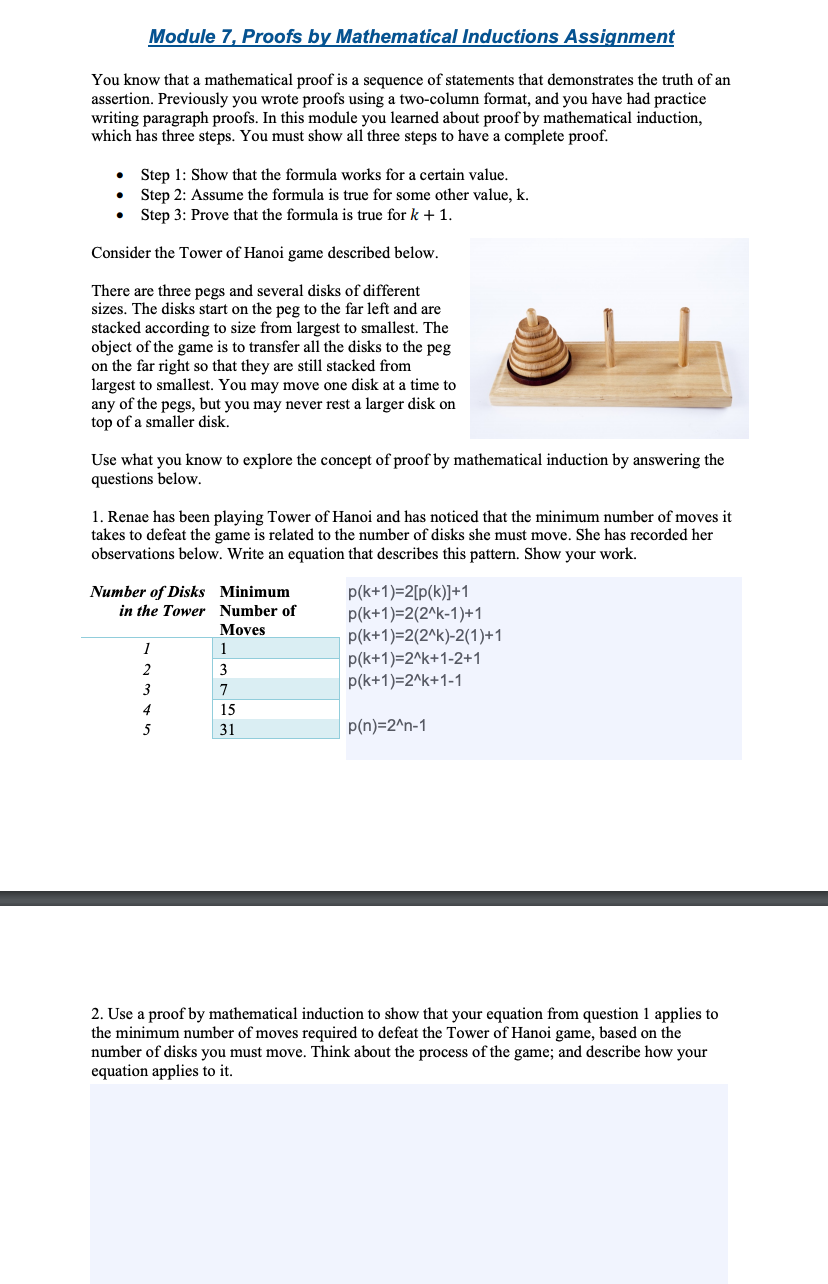



Answered Consider The Tower Of Hanoi Game Bartleby
1 n 2 ( n − 1) 3 ( n − 2) ⋯ ( n − 1) 2 n 1 = ( n 2 3) Solution To give a combinatorial proof we need to think up a question we can answer in two ways one way needs to give the lefthandside of the identity, the other way needs to be the righthandside of the identity Proving that123n is n (n1)/2 Here are four proofs One is very simple arithmetic, the second is nth Triangular number,123n is n (n1)/2 This is a visual one involving only the formula for the area of a rectangle This Given an integer N, the task is to find the sum of series 2 0 2 1 2 2 2 3 2 n Examples Input 5 Output 31 2 0 2 1 2 2 2 3 2 4 = 1 2 4 8
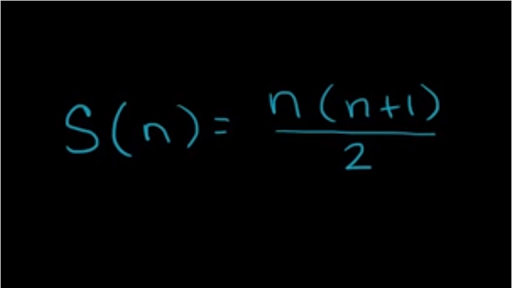



Proof Of Finite Arithmetic Series Formula By Induction Video Khan Academy




Using Principle Of Mathematical Induction Prove That 1 1 2 3 1 2 3 4 1 3 4 5 Maths Continuity And Differentiability Meritnation Com
Hence, the identity holds when n = 1Two sample induction problems 1 Find a formula for 1 4 7 (3n 2) for positive integers n, and then verify your formula by mathematical inductionSo on the left side use only the (2n1) part and substitute 1 for n On the right side, plug in 1 They should both equal 1 Then assume that k is part of the sequence And replace the n with k Then solve for k1 k1 135 (2k1) (2k1)=k^22k1 The right hand side simplifies to (k1)^2




Proof By Induction Wolfram Demonstrations Project




1 2 3 4 Wikipedia
6 P ALEXANDERSSON Solution6 (a) Base case is n= 2The left hand side is just 1−1 4 while the right hand side is 3 4, so both sides are equal Suppose now that Yn j=2 1− 1 j2 n1 2n for some n≥2 After multiplying both sides with 1− 1 (n1)2 we getnY1 j=2 1−F) Explain why these steps show that this formula is true for all positive integers n a) P(1) is the statement 13 = ((1(1 1)=2)2 b) This is true because both sides of the equation evaluate to 1 c) The induction hypothesis is the statement P(k) for some positive integer k, that is, the statement 1323 k3 = (k(k1)=2)2Solutions to Exercises on Mathematical Induction Math 1210, Instructor M Despi c 8 2 23 25 22n 1 = 2(22n 1) 3 Proof For n = 1, the statement reduces to 2 = 2(22 1) 3




Prove That 1 2 2 2 3 2 N 2 N N 1 2n 1 6 Youtube
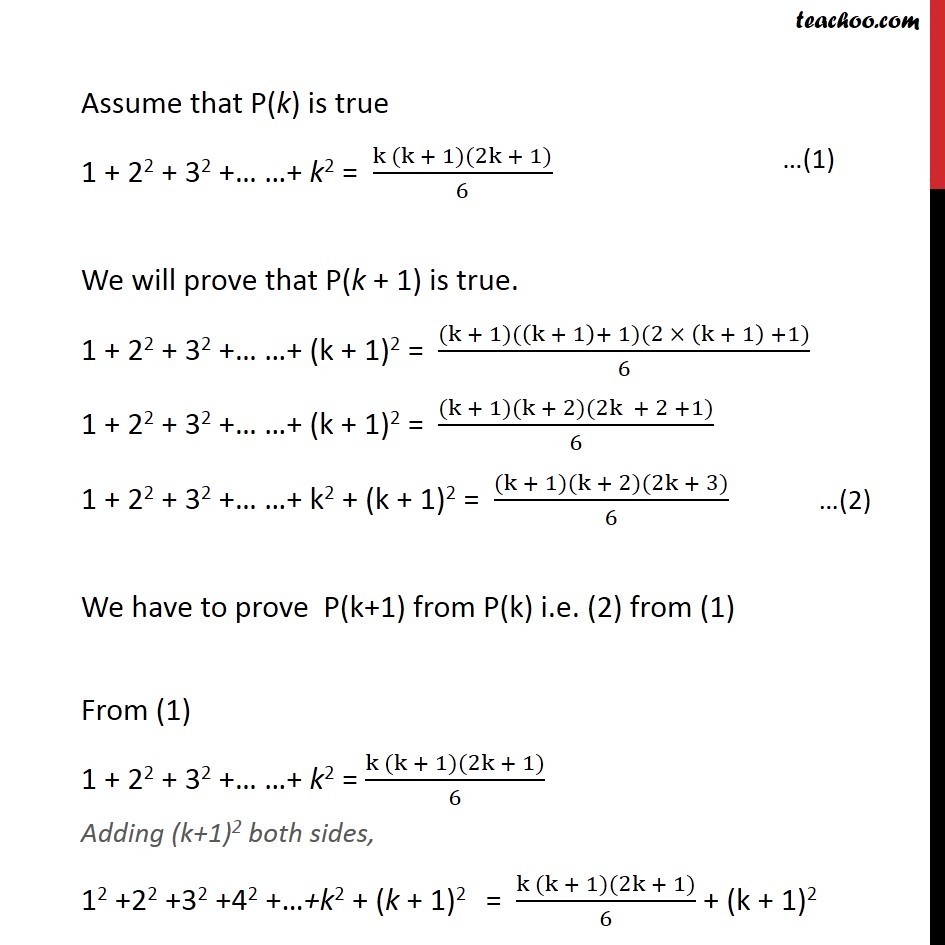



Prove By Induction 1 2 2 2 3 2 4 2 N 2 N N 1 2n 1 6
To do this, we will fit two copies of a triangle of dots together, one red and an upsidedown copy in green Eg T (4)=1234 So this have to hold for every k, and this concludes the proof Here's a proof by induction, considering N terms, but it's the same for N 1 For N = 0 the formula is obviously true We'll prove 1 2 3 N (N 1) = (N 1) (N 2) /
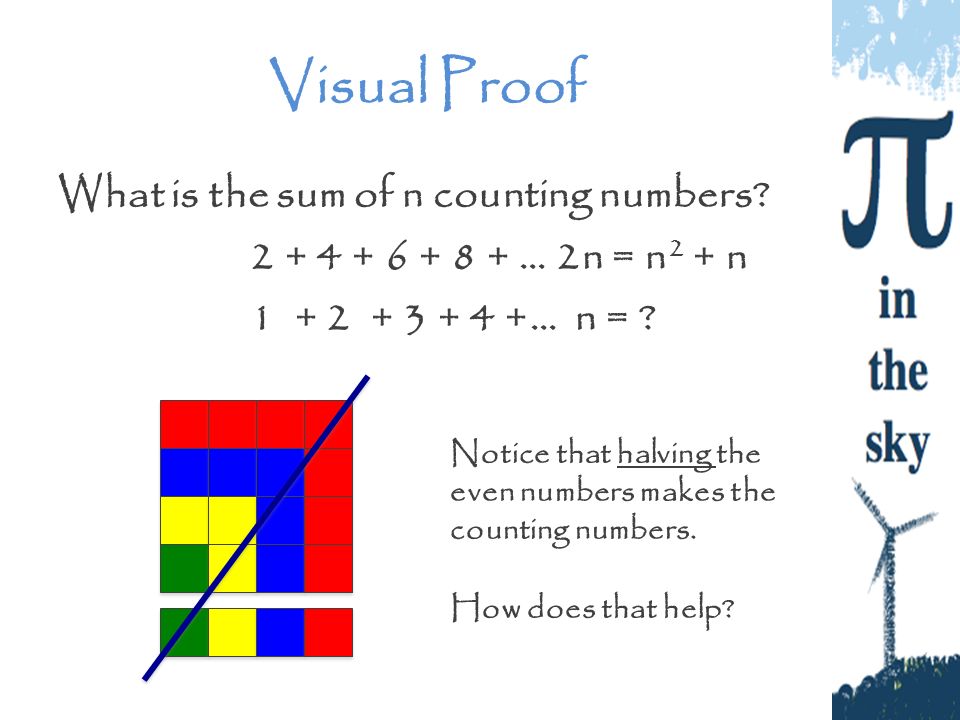



Proof Uniquely Mathematical And Creative Ppt Download




n2 Formula




Infinite Series
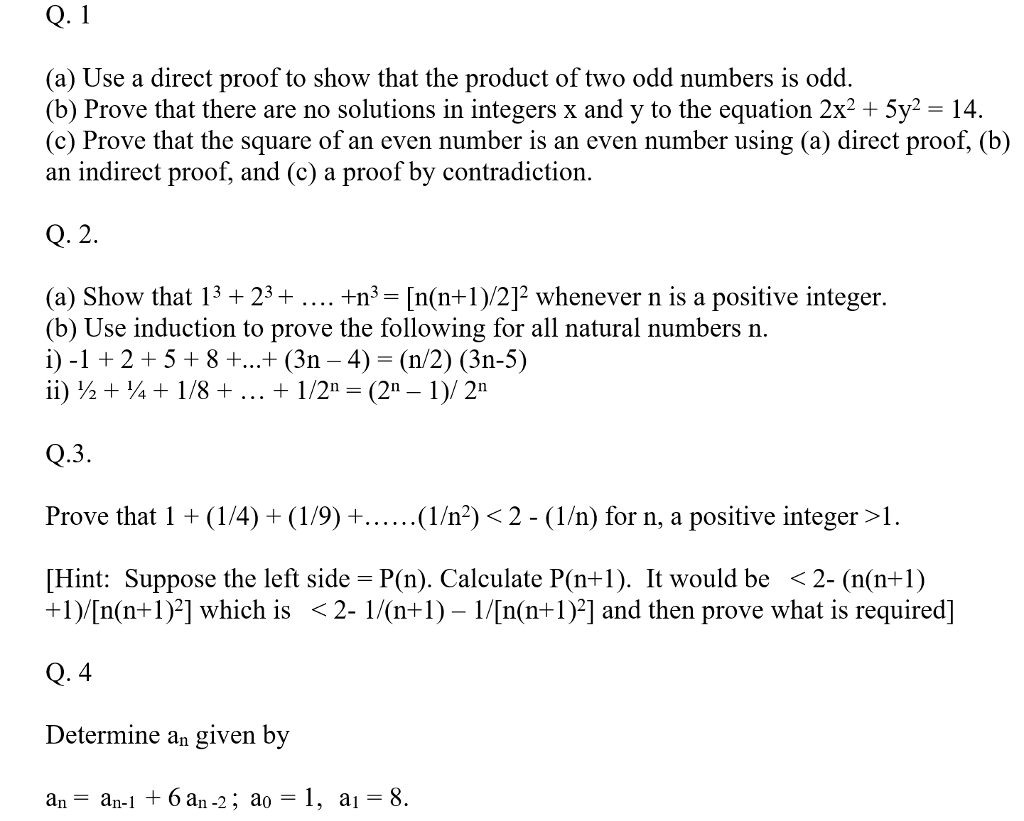



n2 Formula Proof




Prove That 1 2 2 2 3 2 1 N 1 N 2 1 N 1 Frac N N 1 2 Whenever N Is A Positive Integer Using Mathematical Induction Mathematics Stack Exchange




Other N N N 2 Proof Math Math Equation Formula



How To Prove Math 1 3 2 3 3 3 N 3 N 2 N 1 2 4 Math Quora




Proof By Induction Wolfram Demonstrations Project




Proof Of 1 2 2 2 Cdots N 2 N 3 3 N 2 2 N 6 Mathematics Stack Exchange
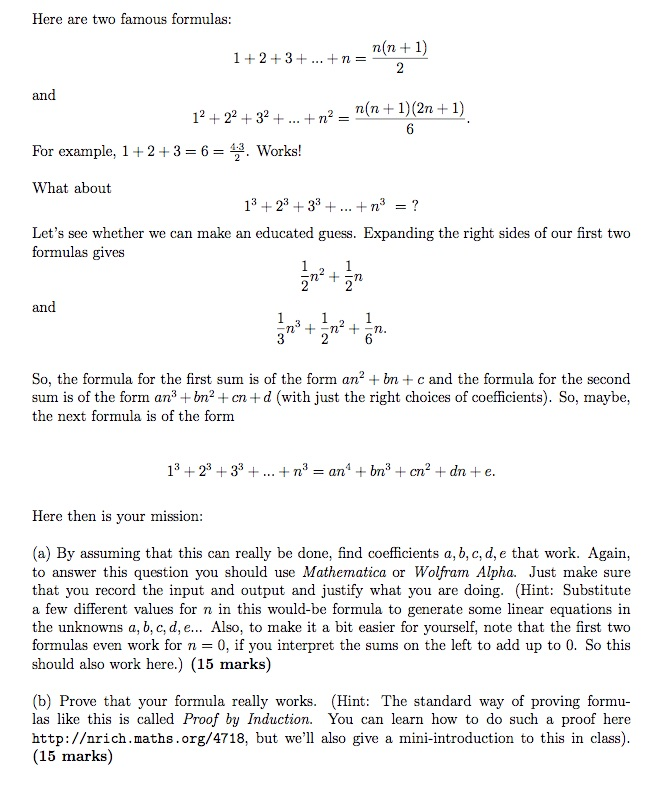



Solved Here Are Two Famous Formulas N N 1 1 2 2 N Chegg Com




Binomial Theorem Properties Terms In Binomial Expansion Examples Pdf




Sum Of N N Or N Brilliant Math Science Wiki
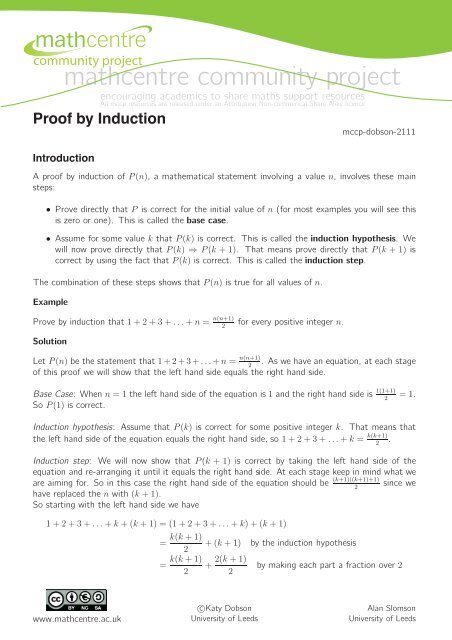



Proof By Induction Revision Mathematics



What Is The Value Of 1 2 2 2 3 2 N 2 Quora




Ipe Material Notes




Homework 4 Questions Introduction To Bioinformatics Math 304 Docsity
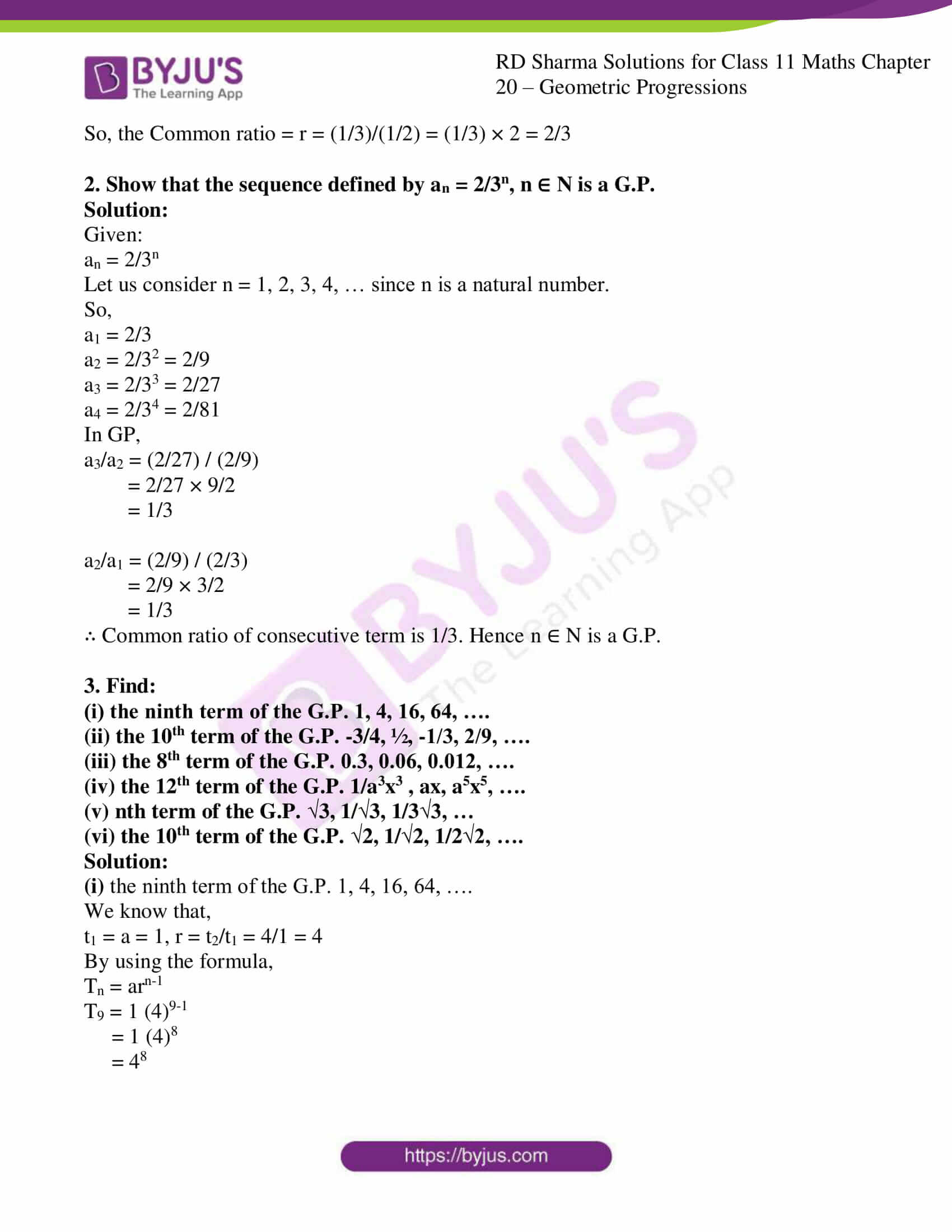



Rd Sharma Solutions For Class 11 Maths Updated 21 22 Chapter Geometric Progressions Download Free Pdf Available
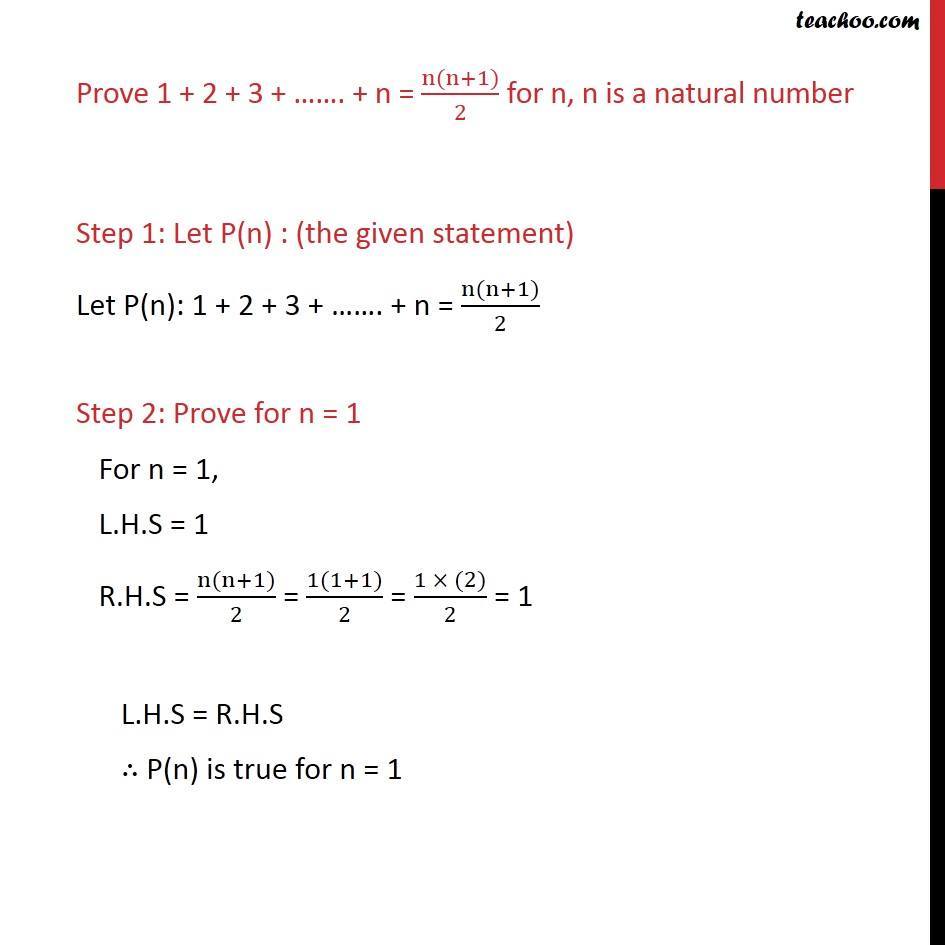



Prove 1 2 3 N N N 1 2 Mathematical Induction



1



Http Www Kau Edu Sa Getfile Aspx Id Fn Assignments 2 mathematical induction1 Pdf




Basel Problem Wikipedia




Proofs Without Words And Beyond Proofs Without Words 2 0 Mathematical Association Of America




n2 Formula




Sum Of N N Or N Brilliant Math Science Wiki
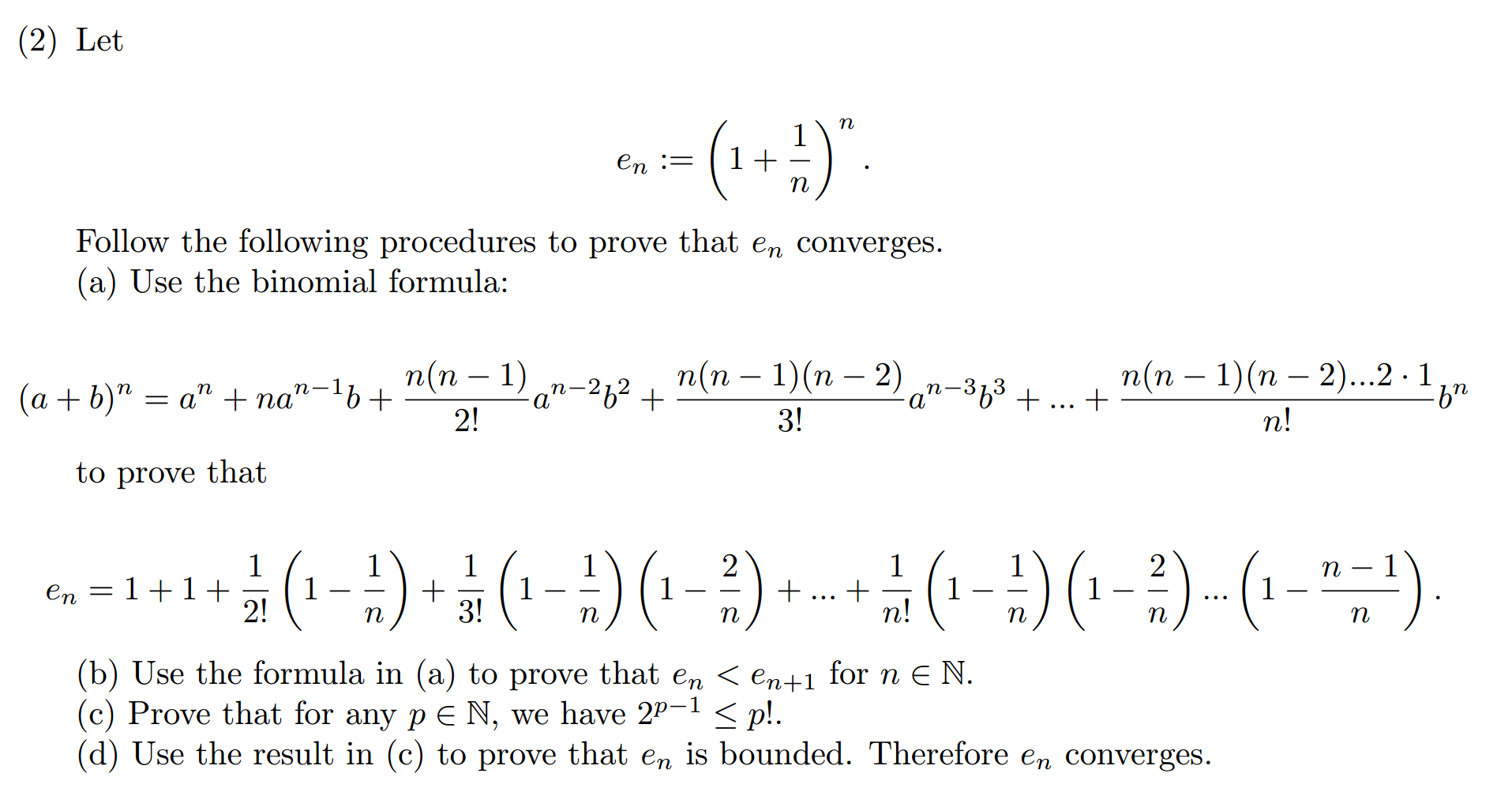



n2 Formula
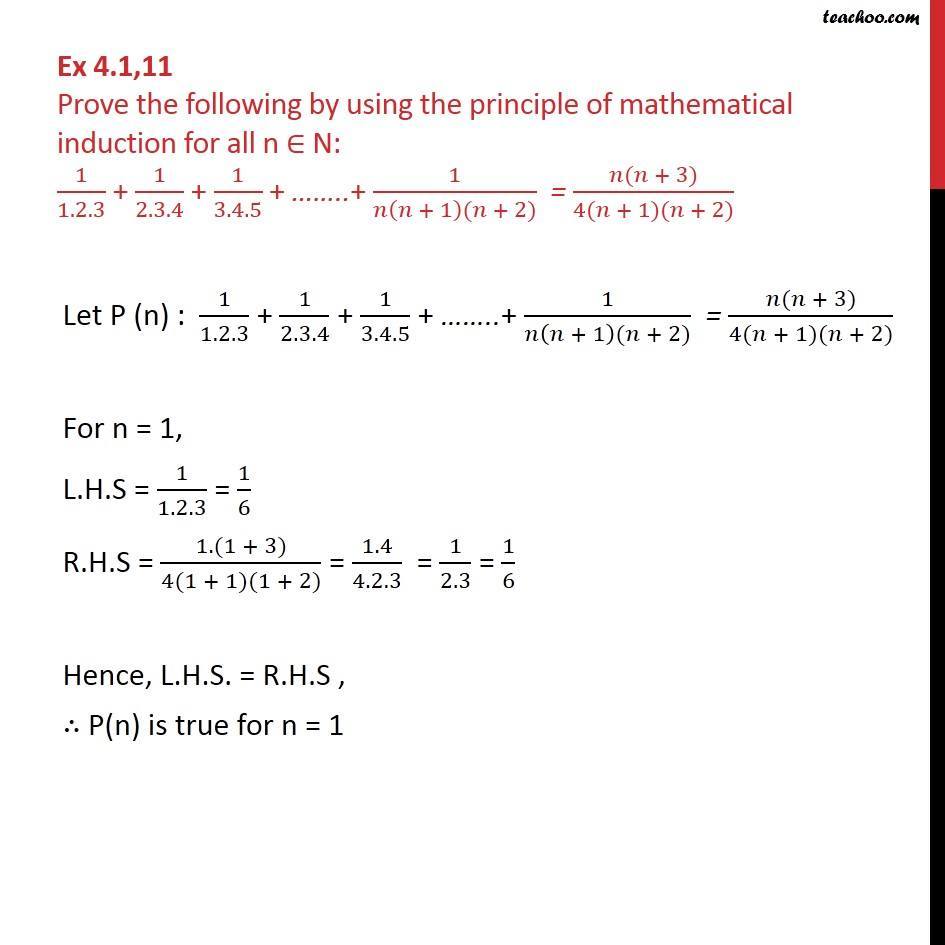



Ex 4 1 11 Prove 1 1 2 3 1 2 3 4 1 3 4 5 1 N N 1 N 2




Prove By Induction Sum Of The First N Cubes 1 3 2 3 3 3 N 3 Youtube




n2 Formula




Answers By Adenguo Issuu




How To 12 Proof By Induction 1 3 2 3 3 3 N 3 N N 1 2 2 N 2 N 1 2 4 Prove Mathgotserved Youtube




The Wallis Product Formula For Pi And Its Proof Mind Your Decisions



What Is The Sum Of The Series Math 1 1 2 1 3 1 4 1 5 Math Up To Infinity How Can It Be Calculated Quora
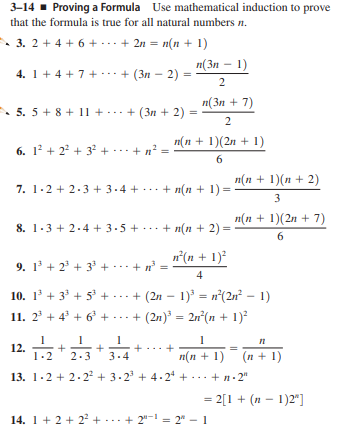



Answered 3 14 Proving A Formula Use Bartleby




Mathematical Thinking Answers By Benjaaaaaa Issuu
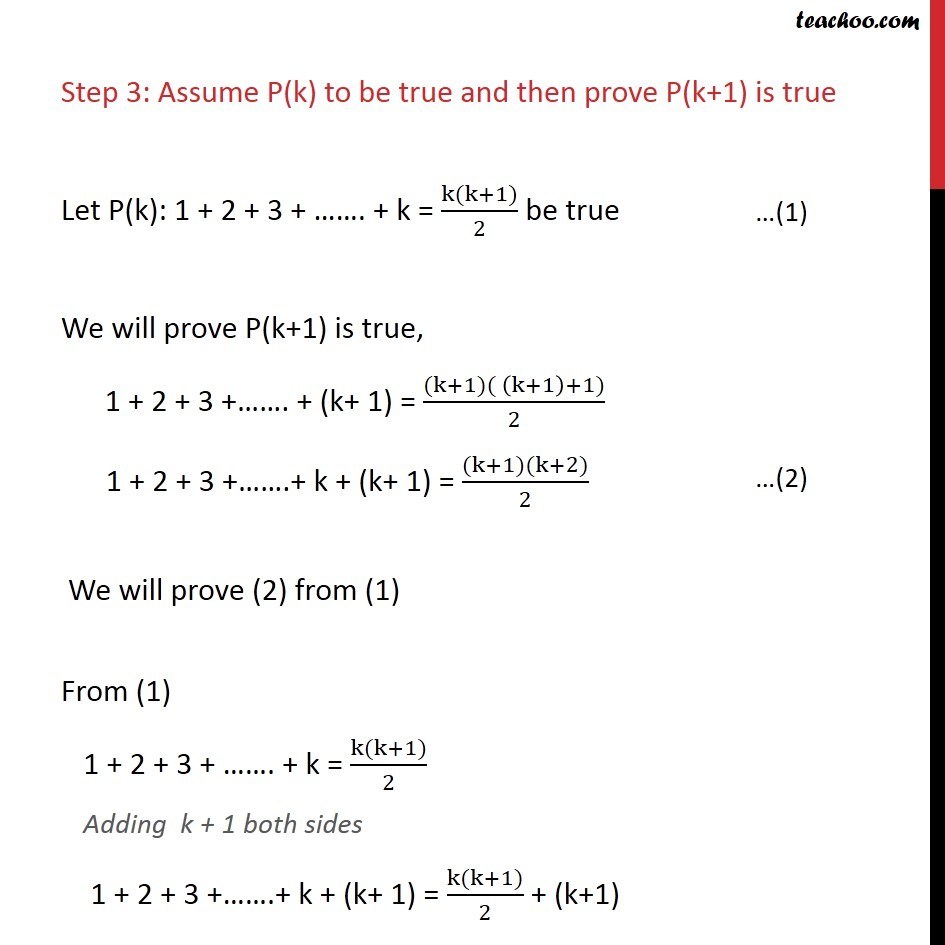



Prove 1 2 3 N N N 1 2 Mathematical Induction




Math Induction
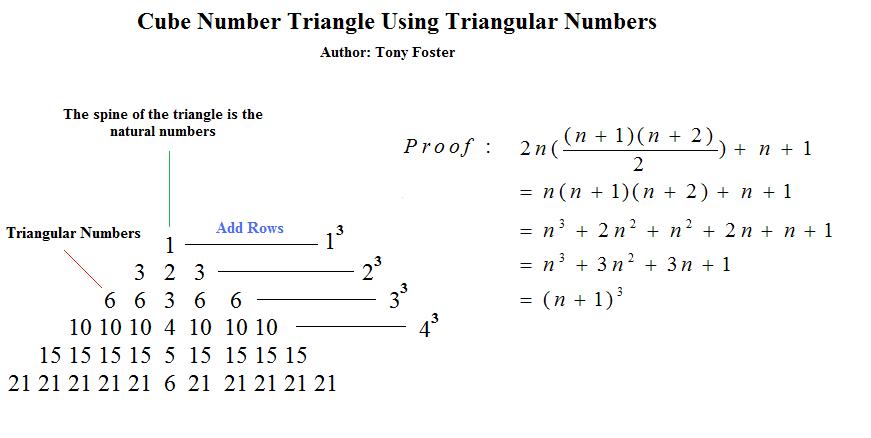



Fascinating Triangular Numbers By Shyam Sunder Gupta
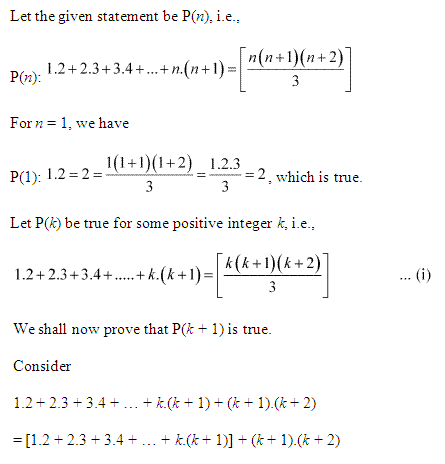



Ncert Solutions For Class 11 Maths Chapter 4 Principle Of Mathematical Induction




Use Principle Of Mathematical Induction It Can Be Proved 1 3 2 3 3 3 N 3 N N 1 2 2 For All N N




n2 Formula Proof
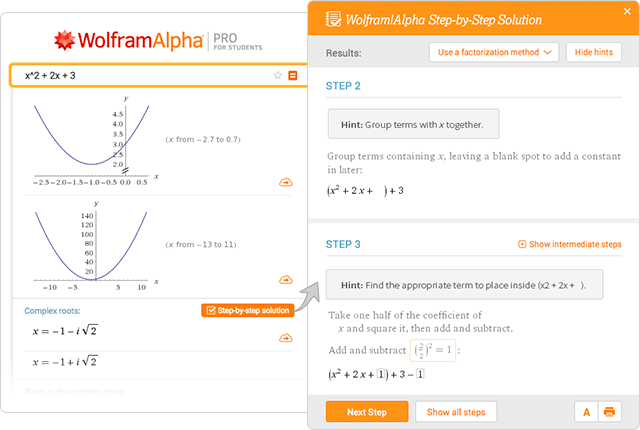



Wolfram Alpha Examples Step By Step Solutions




Pdf Proof Without Words Sums Of Powers Of Natural Numbers




Cube Algebra Wikipedia
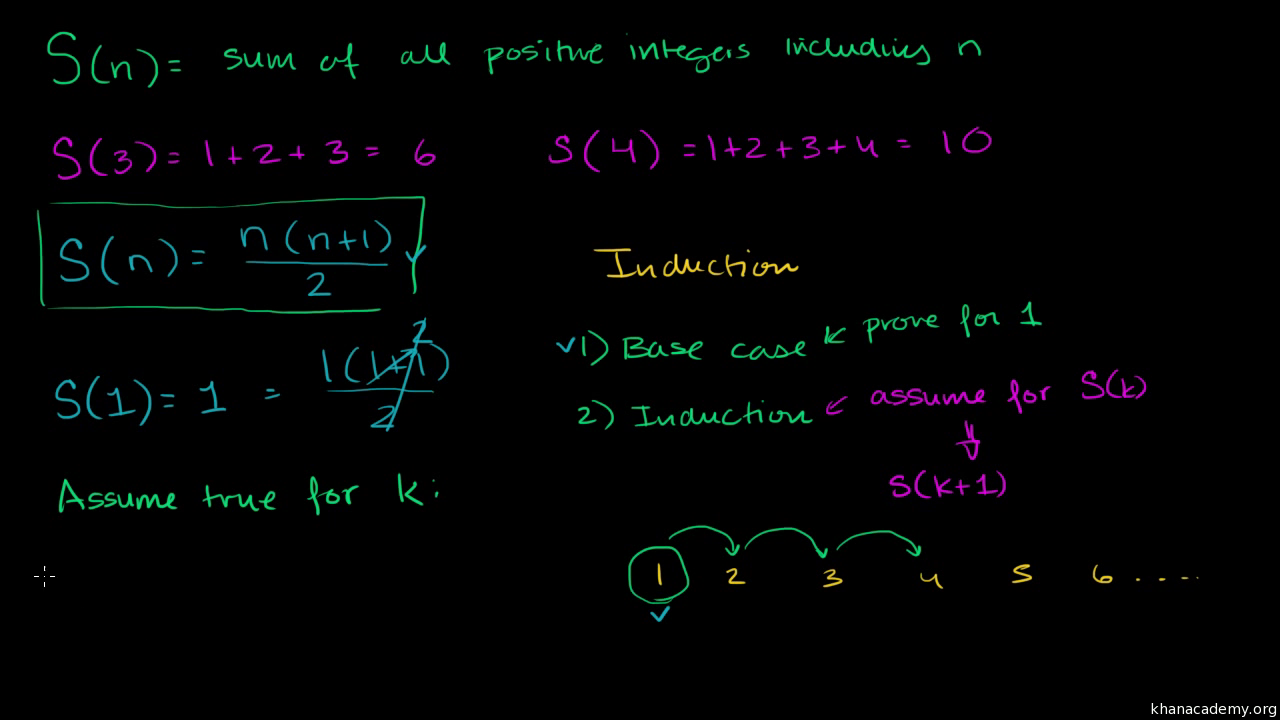



Proof Of Finite Arithmetic Series Formula By Induction Video Khan Academy




Derivation Formula Sum Of First N Squares Or Square Numbers 1 2 2 2 3 2 4 2 N 2 Youtube




Prove By Induction 1 2 2 2 3 2 4 2 N 2 N N 1 2n 1 6



1




2 4 6 8 2n N N 1 Proved With Mathematical Induction Plz Help Me Brainly In




Basel Problem Wikipedia
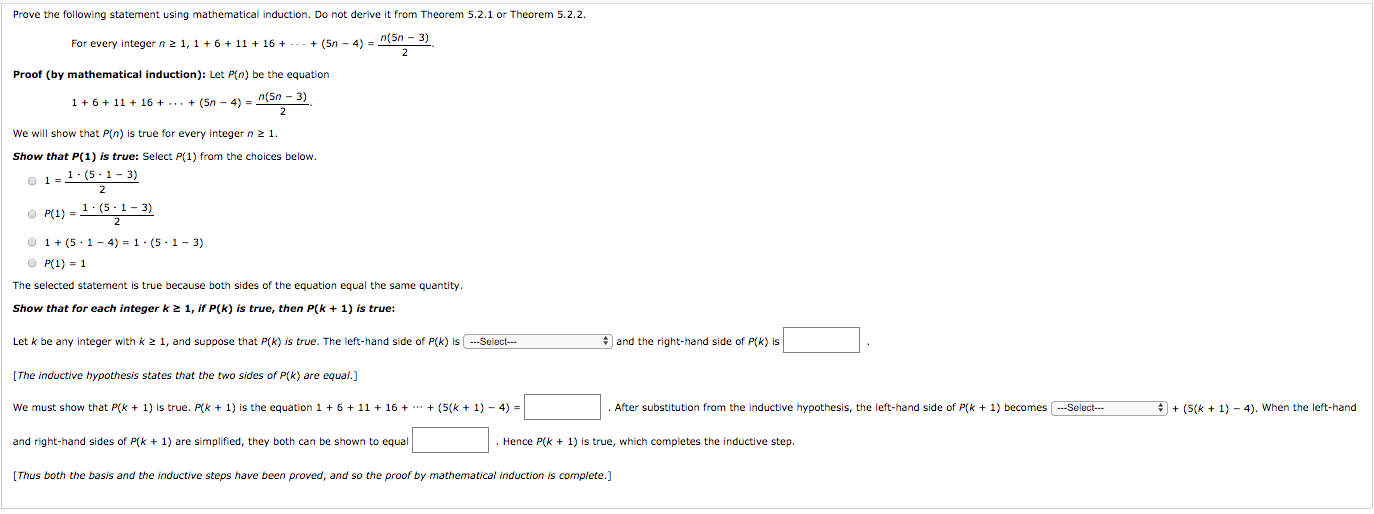



Prove The Following Statement Using Mathematical Chegg Com




A N Excerpt From The Chapter Sequence In The Textbook 4 Download Scientific Diagram
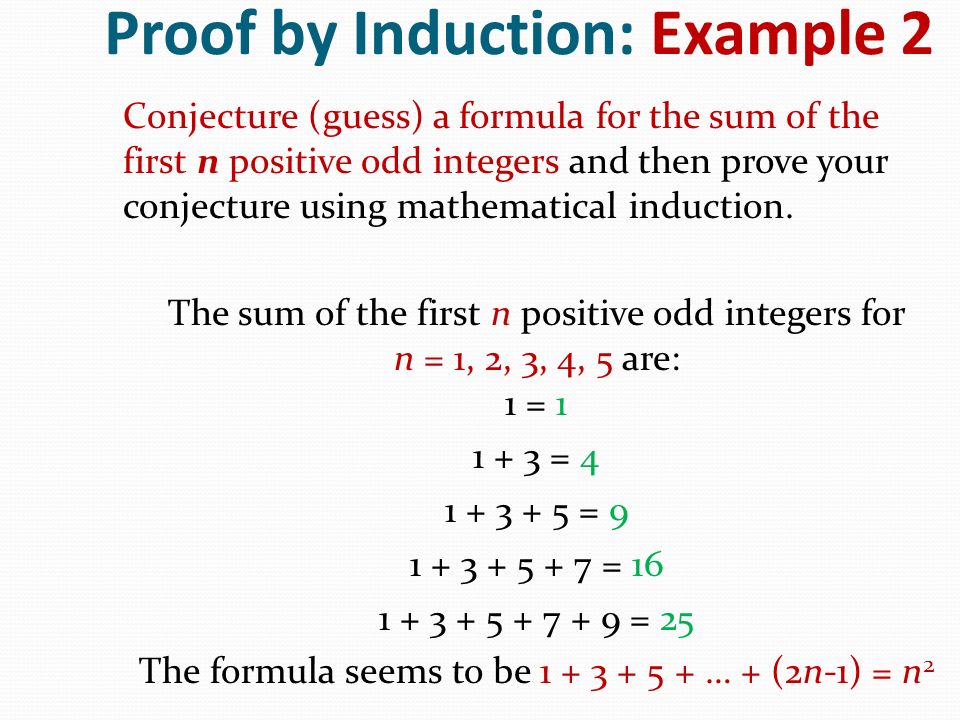



Cs 103 Discrete Structures Lecture 13 Induction And Recursion 1 Ppt Video Online Download
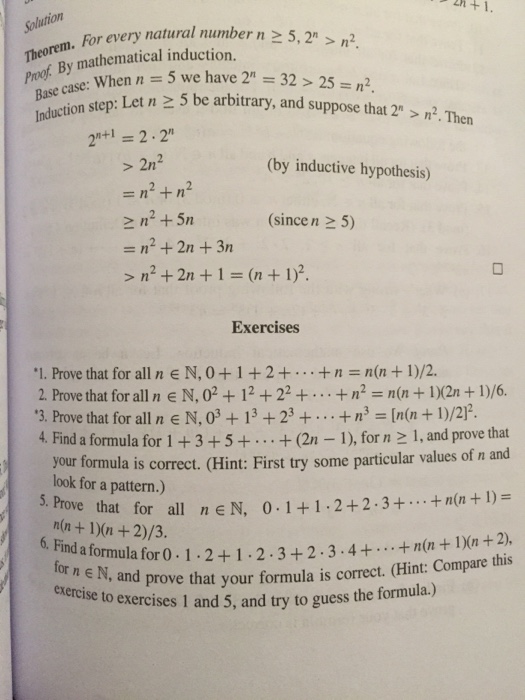



Solution Corem For Every Natural Number N5 2 N2 Chegg Com




Pdf Formulas For Pi N And The N Th Prime




Sum Of Squares Of Odd Numbers 1 2 3 2 5 2 2n 1 2 Derivation Formula Prmo Rmo Iit Youtube



Search Q Mathematical Induction Tbm Isch




Convergent Divergent Geometric Series With Manipulation Video Khan Academy




n2 Formula Proof




Answered Prove The Following Statement By Bartleby
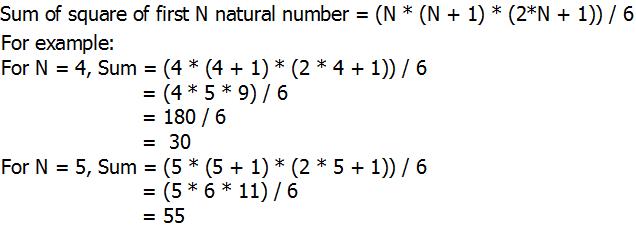



Python Program For Sum Of Squares Of First N Natural Numbers Geeksforgeeks



How To Prove That Math Frac 2 N 2 N 1 2 N 1 2 N 3 2 Quora




n2 Formula
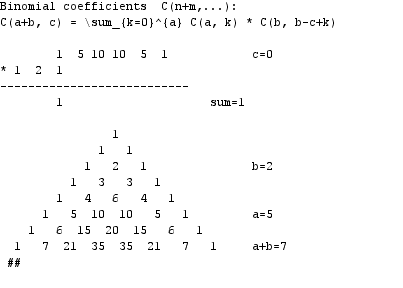



A Oeis




Prove By Induction That 1 2 2 2 3 2 N 2 Youtube



2



Faculty Math Illinois Edu Hildebr 213 Inductionsampler Pdf




Prove 1 2 3 N N N 1 2 Mathematical Induction
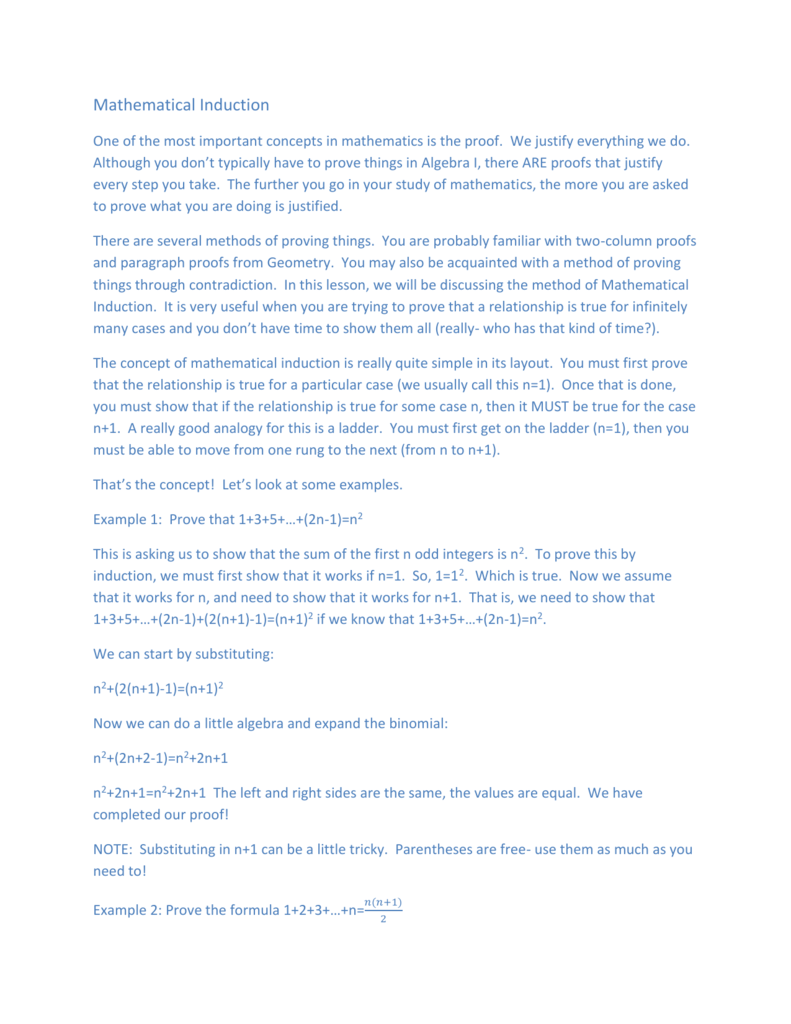



Module 9 Lesson 3 Mathematical Induction Notes




1 3 2 3 3 3 N 3 And Its Geometry Youtube




How To Prove That Math Frac 2 N 2 N 1 2 N 1 2 N 3 2 Quora




13 Gamma Function 1 Definitions Properties 2 Digamma
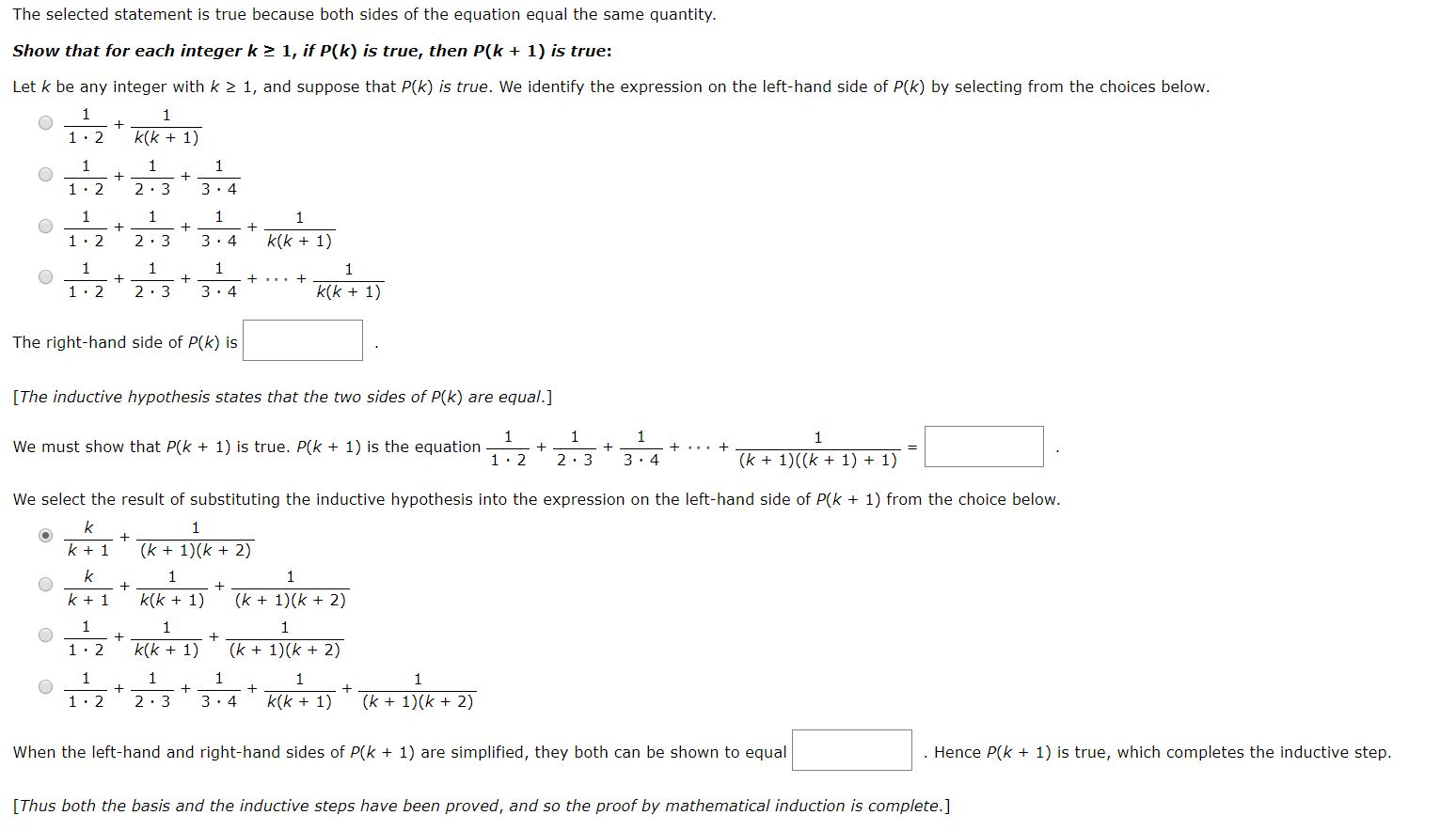



Prove The Following Statement By Mathematical Chegg Com
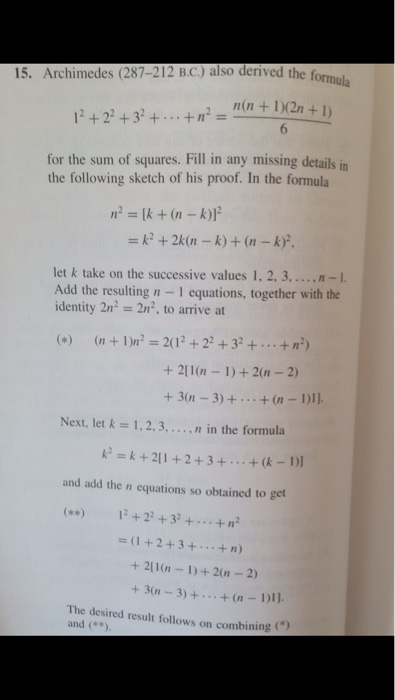



Archimedes 287 212 B C Also Derived The Formula Chegg Com
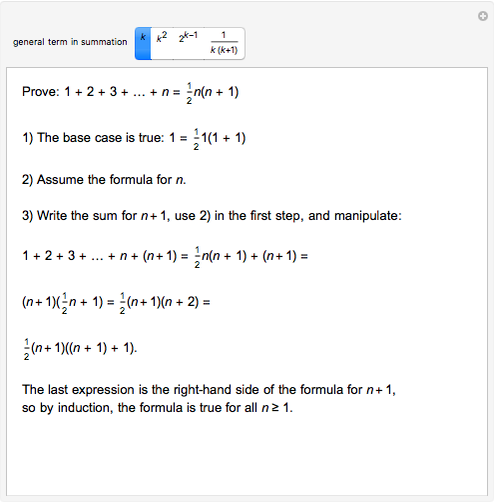



Proof By Induction Wolfram Demonstrations Project
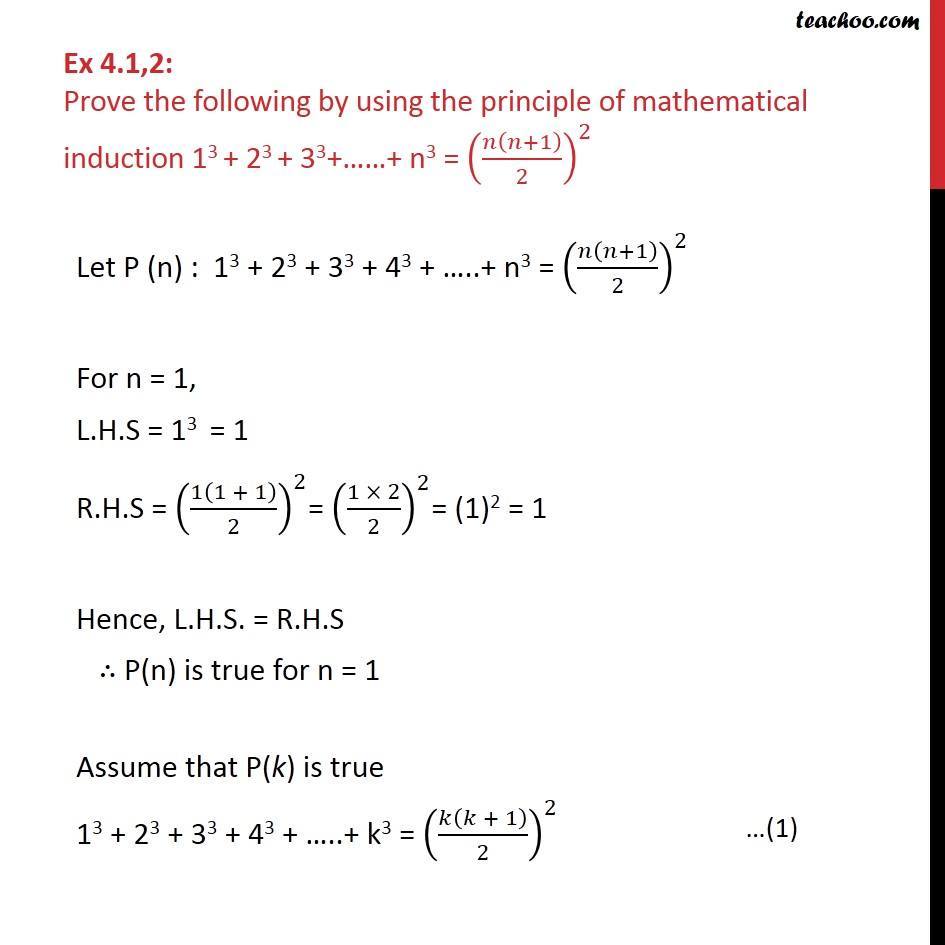



Prove That 1 3 2 3 3 3 N 3 N N 1 2 2 Teachoo
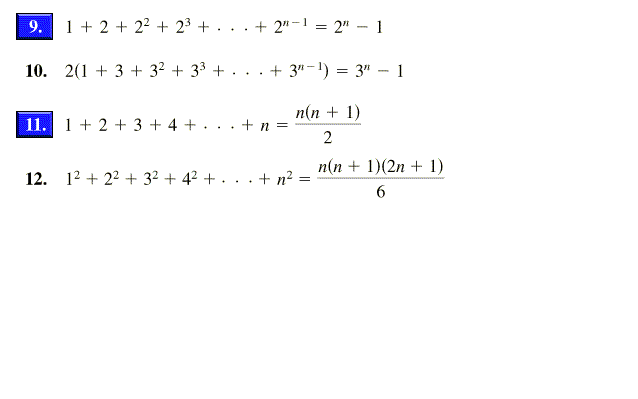



In Exercises 5 18 Use Mathematical Induction To Chegg Com




File Animated Proof For The Formula Giving The Sum Of The First Integers 1 2 N Gif Wikimedia Commons




Basel Problem Wikipedia
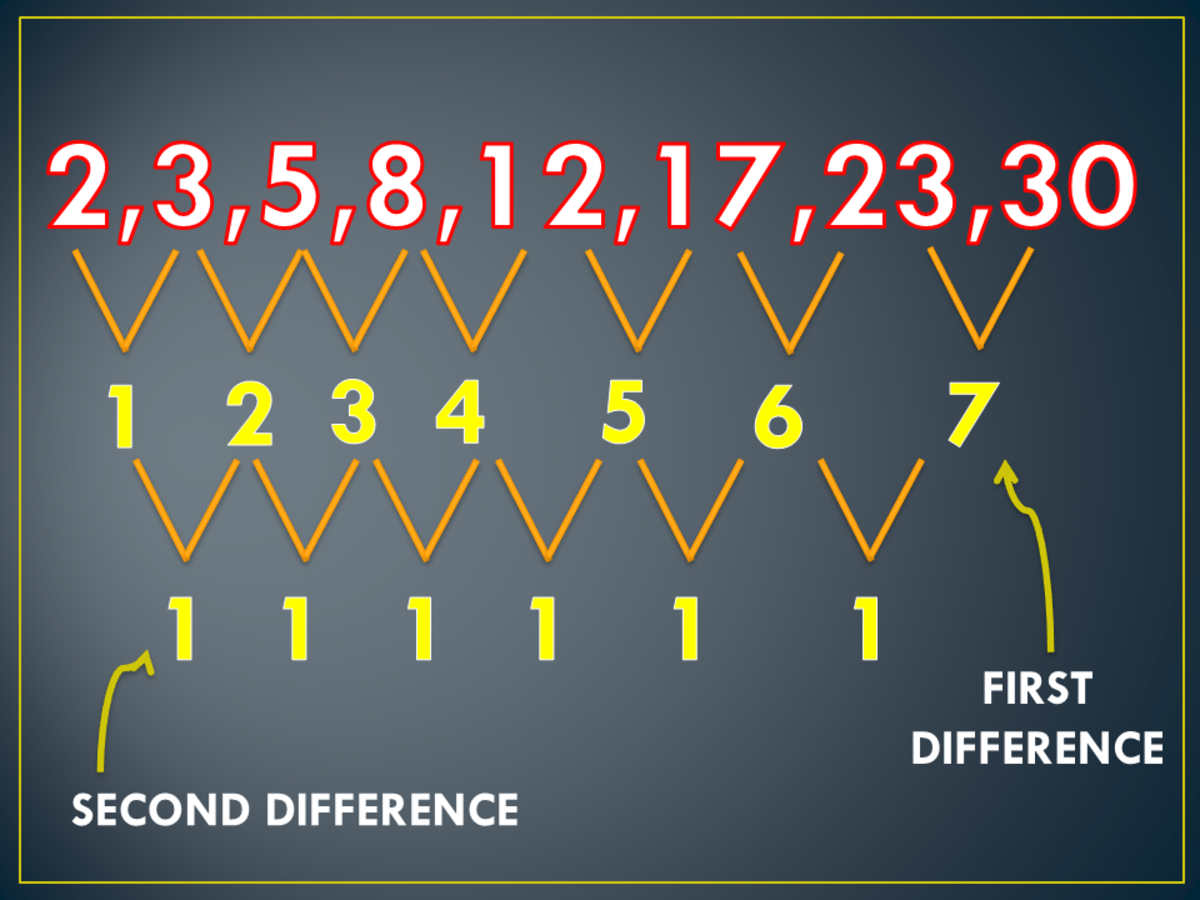



How To Find The General Term Of Sequences Owlcation




Principle Of Mathematical Induction Introduction Videos And Examples



0 件のコメント:
コメントを投稿